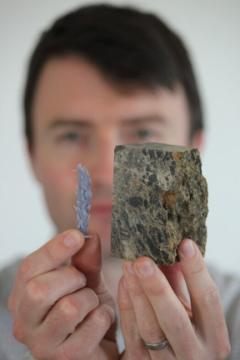Sandy Hetherington wins the European Research Council Starting Grant 2023
Dr Sandy Hetherington, UKRI Future Leaders Fellow, has been awarded a prestigious European Research Council (ERC) Starting Grant to investigate the evolution of Fibonacci spirals.

These highly competitive ERC Starting Grants recognise Europe’s talented, emerging research leaders, supporting early-career scientists to pursue their most promising ideas and develop their teams.

This year the ERC awarded 400 Starting Grants across Europe, worth a total of €628 million, including 32 projects to be hosted in the UK.
The award value of €1.5 million is being granted for Sandy’s project “WhyFib” – which aims to answer a major evolutionary question ‘Why are Fibonacci spirals so common in plants today?’.
Dr Sandy Hetherington leads the Molecular Palaeobotany and Evolution Group at the Institute of Molecular Plant Sciences at the University of Edinburgh.
Spiral patterns in plants
In nature, spiral patterns are very common, for example, the DNA double helix being one of them. Most of these can be described by one of the most famous mathematical series the Fibonacci sequence. Spirals are common in plants, in their flower petals, leaves or seeds, with Fibonacci spirals making up over 90% of the spirals.
However, why these spirals are so common is not known and this is something Sandy and his team will be investigating with the grant. He will do this by taking an interdisciplinary approach combining studies of fossils and living plants to study the evolutionary history of Fibonacci spirals in land plants.
Why Fibonacci spirals?
Understanding the drivers of biological form over geological time is one of the grand challenges in evolutionary biology. What makes this question so challenging, is the fact that only a few study systems exist where it is possible to test the competing roles of selection, constraint and chance.
Land plants offer a largely overlooked but ideal study system for tackling these questions because of their excellent fossil record and close relationship between form, function and development.
Sandy will leverage all of these benefits to uncover the evolutionary drivers behind one of the key features of land plants, the arrangement of leaves.
On theoretical grounds, plant leaves could be positioned on stems in a large number of possible arrangements. However, they are not.
They are arranged in a very restricted number of discrete patterns, of which by far the most frequent are spirals that are described by integers of the Fibonacci series.
Why Fibonacci spirals are so frequent in plants has perplexed scientists for centuries and remains a major unanswered question. In WhyFib, Sandy will address this question by taking a broad evolutionary approach, underpinned by his interdisciplinary background and breakthrough methodologies developed in his lab.
To uncover the evolutionary history of Fibonacci spirals we will combine results gained from investigating development in non-seed plants with insights from newly collected fossils, analyses of quantitative trait evolution and quantitative modelling approaches. We will then use these data, representing over 400 million years of evolution, to test the major competing hypotheses for the prevalence of Fibonacci spirals
Related Links

